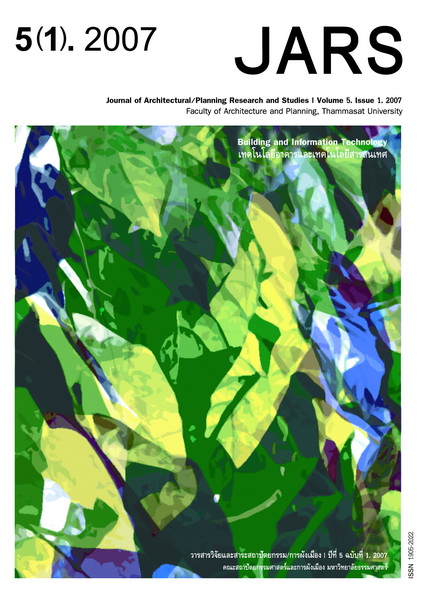Off Grid: Meaning, Technologies, and Applications
Main Article Content
Abstract
“Off grid” or “off the grid” refers to a building or buildings that are not connected to any public
utility systems. Energy, water, and waste disposal are dealt with on site without any ties to a municipal
system. This overview and analysis addresses the apparent lack of knowledge and expertise in this area
not only at the most basic levels but also the void that exists within the intelligentsia as to what it takes
to go off grid and what that means. Off grid is its own entity and not just part of sustainability, conversely,
off grid most often does incorporate sustainability. Many resources exist on the individual components
of an off grid system but there is little information available that addresses how to combine these
components into a building for it to become off grid and thus the prevalent ignorance among laypersons
and scholars alike. This paper houses them together and shows how they relate to the overall built
environment.
Downloads
Article Details

This work is licensed under a Creative Commons Attribution-NonCommercial-NoDerivatives 4.0 International License.
All material is licensed under the terms of the Creative Commons Attribution 4.0 International (CC-BY-NC-ND 4.0) License, unless otherwise stated. As such, authors are free to share, copy, and redistribute the material in any medium or format. The authors must give appropriate credit, provide a link to the license, and indicate if changes were made. The authors may do so in any reasonable manner, but not in any way that suggests the licensor endorses you or your use. The authors may not use the material for commercial purposes. If the authors remix, transform, or build upon the material, they may not distribute the modified material, unless permission is obtained from JARS. Final, accepted versions of the paper may be posted on third party repositories, provided appropriate acknowledgement to the original source is clearly noted.
References
Brown, P. L. (2001, January 24). Home-grown energy’s time to shine. The New York Times.
Edinger, R., & Kaul, S. (2000). Humankind’s detour toward sustainability: Past, present, and future of renewable energies and electric power generation. Renewable and Sustainable Energy Reviews, 4(3), 295-313.
Building momentum: National trends and prospects for high-performance green buildings. Retrieved February 2003, from U.S. Green Building Council Web site: www.usgvc.org/docs/resources/043003-hpgb-whitepaper.pdf
Kats, G. H. (2003). The costs and financial benefits of green buildings: A report developed for California’s sustainable building task force. Retrieved October 2003, from Capital E Web site: www.cap-e.com/
Newton, L., & Warner, P. (2007, July/August). Proclaiming the green revolution. Eco-structure, 5.
Pacific Environment. Photovoltaics. Retrieved from http://www.pacificenvironment.org/article.php?id=283
Johansson-Pereira, J. Eastern fa¬ade of Four Times Square. Retrieved from http://www.ieapvps.org/cases/usa_01.htm
Zahedi, A. (2006). Solar Photovoltaic (PV) energy; Latest developments in the building integrated and hybrid PV systems. Renewable Energy, 31(5), 711-718.
Zawodzinski, T. Proton exchange membrane. Case Western Reserve University.
Swisher, J. N. (2002). Cleaner energy, greener profits: Fuel cells as cost effective distributed energy resources, document U02-02. Retrieved from http:// www.rmi.org/images/other/Energy/U02-02_CleanerGreener.pdf
U.S. Department of Energy. (n.d.). Fuel cell chart. Retrieved from http://www.eere.energy.gov/hydrogenandfuelcells/fuelcells/pdfs/fc_comparison_chart.pdf
Small hydro power systems: Energy efficiency and renewable energy clearinghouse, DOE/GO-102001-1173, FS217. (n.d.). Retrieved July 2001, from National Renewable Energy Laboratory Web site: http://www.nrel.gov/docs/fy01osti/29065.pdf
Microhydropower.net. (n.d.). Micro hydropower. Retrieved from http://www.microhydropower.net/image/dam_text.jpg
Electrical Power Generation. (2006). U.S. Department of Energy Energy efficiency and renewable energy biomass program. Retrieved from http://www1.eere.energy.gov/biomass/printable_versions/electrical_power.html
Community Power Corporation. (n.d.). Biomass for small-scale heat and power. Retrieved from: http:// www.wapa.gov/es/pubs/ESB/2003/dec03/images/BioMaxRuidoso.jpg
Tennessee Valley Authority. (n.d.). Wind turbine. Retrieved from http://www.eas.asu.edu/~holbert/eee463/wind_turbine.gif
Kibert, C. J. (2005). Sustainable construction: Green building design and delivery. Hoboken, NJ: John Wily & Sons.
Sustainable Building Sourcebook. (n.d.). Greywater irrigation. Retrieved August 4, 2006, from Sustainable Sources, Greenbuilding Web site: http://www.greenbuilder.com/sourcebook/Greywater.html
Robert Svadlenka World Hunger Year. (n.d.). Rainwater harvesting. Retrieved from http:// www.worldhungeryear.org/why_speaks/ws_load.asp?file=19&style=ws_table
Sustainable Building Sourcebook. (n.d.). Greywater shallow mound system. Retrieved from http://www.greenbuilder.com/sourcebook/GreyGuidelines.html
Del P. D., & Steinfeld, C. (2000). The composting toilet system book. Center for Ecological Pollution Prevention (CEPP), Concord, MA.
Kitsui, T., & Terazawa, M. (1999). Environmentally-friendly toilets for the 21st century, Bio-toilet. Proceedings of the 10th ISWPC, Yokohama, 3, 120-121.
Zavala, M. A., Lopez, T. T., & Funamizu, N. (2004). Biological activity in the composting reactor of
the bio-toilet system. Department of Environmental Engineering, Graduate School of Engineering, Hokkaido University, Japan.
Composting toilet from real goods. (n.d.). Retrieved from: http://www.solareco.com/articles/article.cfm/id/100


